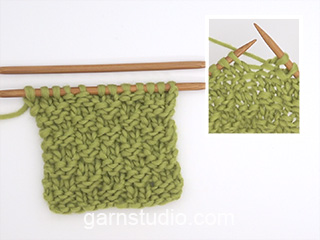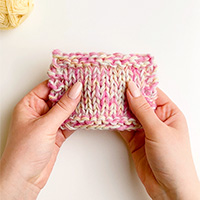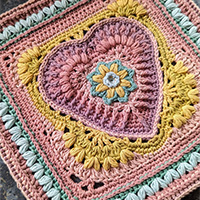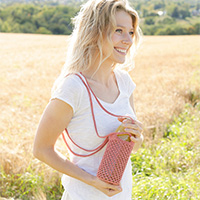Lea |
|||||||
|
|
|||||||
Knitted jacket with wavy edge and textured pattern for baby and children in DROPS BabyAlpaca Silk
DROPS Baby 21-14 |
|||||||
|
DOUBLE SEED ST: 1st row: * K 2, P 2 *, repeat from *-*. 2nd row: K over K and P over P. 3rd row: P over K and K over P. 4th row: As 2nd row. Repeat row 1 to 4. DECREASE TIP: Dec as follows before marker: Beg 2 sts before marker. Slip 1 st as if to K, K 1, psso. Dec as follows after marker: K 2 tog. GARTER ST (back and forth on needle): K all rows. PATTERN: See diagrams M.1 and M.2. The diagrams show the pattern from RS. -------------------------------------------------------- JACKET: Worked back and forth on circular needle. Cast on 366-394-422 (450-478) sts on circular needle size 2.5 mm / US 1or2 with Baby Alpaca Silk. Work rib as follows: 1 st in GARTER ST – see explanation above, P 2, * K 10, P 4 *, repeat from *-* until 13 sts remain and finish with K 10, P 2 and 1 st in GARTER ST. Continue like this until 8-8-12 (12-12) rows in rib have been worked. Now dec 1 st on each side of every K-section by working all K 10 sts as follows (P 4 as before): Slip 1 st as if to K, K 1, psso, K until 2 sts remain, K 2 tog. Repeat dec on every other row a total of 4 times = 158-170-182 (194-206) sts (= K 2/P 4). Work 1 row from WS with K over K and P over P. Switch to circular needle size 3 mm / US 2or3. Now K 1 row from RS while AT THE SAME TIME dec 44-44-40 (40-36) sts evenly = 114-126-142 (154-170) sts. Insert a marker after 29-32-36 (39-43) sts and a marker after 85-94-106 (115-127) sts (marks the mid of the sides). Back piece = 56-62-70 (76-84) sts. Now measure the piece from here. Continue in stockinette st and 1 st in Garter st in each side towards mid front until piece measures 10-11-12 (16-18) cm / 4"-4 3/8"-4 3/4" (6 1/4"-7") from marker. Now work diagram M.1. When diagram M.1 has been worked 1 time vertically, continue in DOUBLE SEED ST - see explanation above. When piece measures 18-19-21 (25-28) cm / 7"-7½"-8 1/4" (9 3/4"-11") from marker, bind off 6 sts in each side (i.e. 3 sts on each side of every marker) for armholes. Then finish front and back piece separately. BACK PIECE: = 50-56-64 (70-78) sts. Continue back and forth in double seed st. AT THE SAME TIME bind off for armholes in beg of each row each side: 2 sts 1 time and 1 st 2 times = 42-48-56 (62-70) sts. When piece measures 21-22-24 (28-31) cm / 8 1"-8 3/4"-9½" (11"-12 1/4"), work diagram M.2 over all sts. When diagram M.2 has been worked 1 time vertically, continue in double seed st until piece measures 25-27-30 (35-39) cm / 9 3/4"-10 5/8"-11 3/4" (13 3/4"-15 1/4"). Now bind off the middle 20-22-24 (26-28) sts for neck and finish each part separately. Continue to dec 1 st on the next row towards the neck = 10-12-15 (17-20) sts remain on each shoulder. Continue until piece measures 27-29-32 (37-41) cm / 10 5/8"-11 3/8"-12½" (14½"-16 1/8") from marker. Loosely bind off. Piece measures 32-34-38 (43-47) cm / 12½"-13 3/8"-15" (17"-18½") in total. LEFT FRONT PIECE: = 26-29-33 (36-40) sts. Continue back and forth in Double seed st. AT THE SAME TIME dec for armhole in the side as on back piece = 22-25-29 (32-36) sts. Then when piece measures 21-22-24 (28-31) cm / 8 1"-8 3/4"-9½" (11"-12 1/4"), work diagram M.2 over all sts. When diagram M.2 has been worked 1 time vertically, continue in double seed st. AT THE SAME TIME when piece measures 23-25-27 (31-34) cm / 9"-9 3/4"-10 5/8" (12 1/4"-13 3/8") from marker, slip the 6-7-7 (7-8) sts towards mid front on a stitch holder for neck. Continue to bind off for neck at beg of every row from neck: 2 sts 2 times and 1 st 2-2-3 (4-4) times = 10-12-15 (17-20) sts remain on shoulder. Continue until piece measures 27-29-32 (37-41) cm / 10 5/8"-11 3/8"-12½" (14½"-16 1/8") from marker. Loosely bind off. Piece measures 32-34-38 (43-47) cm / 12½"-13 3/8"-15" (17"-18½") in total. RIGHT FRONT PIECE: Work as left front piece but reversed. SLEEVE: Worked back and forth on needle. Cast on 44-44-44 (50-50) sts on needle size 2.5 mm / US 1or2 with Baby Alpaca Silk. P 1 row from WS. Then work rib (1st row = from RS) P 4/K 2 with 1 edge st in each side. When rib measures 3-3-4 (4-4) cm / 1 1/8"-1 1/8"-1½" (1½"-1½"), K 1 row from RS while AT THE SAME TIME dec 6-4-4 (8-6) sts evenly = 38-40-40 (42-44) sts. Switch to needle size 3 mm / US 2or3. Work back and forth in stockinette st with 1 edge st in garter st each side. AT THE SAME TIME when piece measures 5 cm / 2'', inc 1 st in each side, repeat inc every 4-2½-2 (2-2) cm / 1½"-7/8"-3/4" (3/4"-3/4") a total of 3-5-7 (9-10) times = 44-50-54 (60-64) sts. AT THE SAME TIME when piece measures 11-13-14 (17-19) cm / 4 3/8"-5 1/8"-5½" (6 3/4"-7½"), work diagram M.2. When diagram M.2 has been worked 1 time vertically, continue in DOUBLE SEED ST. NOTE! Make sure that the double seed st is the same in each side when beg to work. Continue to inc in each side – work the inc sts in double seed st. Work until piece measures 17-19-21 (25-29) cm / 6 3/4"-7½"-8 1/4" (9 3/4"-11 3/8"). Now bind off 3 sts in beg of next 2 rows for sleeve cap. Continue to bind off for sleeve cap at beg of every row in each side: 3 sts 0-0-0 (1-1) time, 2 sts 2-3-3 (3-3) times and 1 st 3-1-0 (0-0) times. Then bind off 2 sts in each side until piece measures 21-23-25 (29-33) cm / 8 1/4"-9"-9 3/4" (11 3/8"-13"). Now bind off 3 sts 1 time in each side. Piece now measures approx. 22-24-26 (30-34) cm / 8 3/4"-9½"-10 1/4" (11 3/4"-13 3/8"). Bind off the remaining sts. ASSEMBLY: Sew the shoulder seams. Sew sleeve seams inside 1 edge st and sew in sleeves. LEFT BAND: Beg at top of neck. Knit up 82-86-94 (106-118) sts on needle size 2.5 mm / US 1or2 from RS inside 1 edge st down along left front piece. K 1 row from WS. Then work rib as follows (from RS): * P 2, K 2 *, repeat from *-* and finish with 2 sts in GARTER ST. Continue to work like this until band measures approx. 2-2-2 (2½-2½) cm / 3/4"-3/4"-3/4" (7/8"-7/8"). Loosely bind off sts with K over K and P over P. RIGHT BAND: Work as on left band but when rib measures approx. 1 cm / 3/8'', bind off for 5-5-6 (6-7) button holes. Bind off for the upper button hole approx. 1 cm / 3/8'' from neck, bind off for bottom button hole approx. 2 cm / 3/4'' from bottom edge. Bind off for the other button holes approx. 6-7-6 (7-6) cm / 2 3/8"-2 3/4"-2 3/8" (2 3/4"-2 3/8") apart. All button holes are bind off in 2 P, by P 2 tog and making 1 YO. Then work rib as before until it measures approx. 2-2-2 (2½-2½) cm / 3/4"-3/4"-3/4" (7/8"-7/8"). Loosely bind off sts with K over K and P over P. COLLAR: Knit up 68 to 96 sts from RS on needle size 3 mm / US 2or3 (including sts on stitch holders) and also knit up sts over front bands in each side (on bands knit up in front loop of outermost st). K 1 row from WS. K 1 row from RS while AT THE SAME TIME adjusting no of sts to 76-84-92 (100-108). K 1 row from WS. Continue in DOUBLE SEED ST over all sts until piece measures approx. 4 cm / 1½''. Loosely bind off. |
|||||||
Diagram explanations |
|||||||
|
|||||||

|
|||||||
|
Have you made this or any other of our designs? Tag your pictures in social media with #dropsdesign so we can see them! Do you need help with this pattern?You'll find tutorial videos, a Comments/Questions area and more by visiting the pattern on garnstudio.com. © 1982-2024 DROPS Design A/S. We reserve all rights. This document, including all its sub-sections, has copyrights. Read more about what you can do with our patterns at the bottom of each pattern on our site. |
|||||||


















































Comments / Questions (73)
When we add the markers, do we still knit the front and back all together as 1 row, I don’t understand why we place the markers here, besides measuring 10 rows from marker?
11.06.2023 - 17:45DROPS Design answered:
Dear Laura, the markers on the sides will be used when dividing piece for armhole, this means add the marker as stated for the size then continue with stocking stitch until piece measures 10 cm from markers on the side (from where it says Now measure the piece from here.. Happy knitting!
12.06.2023 - 09:04Olen tekemässä jakkua pienimmässä koossa ja jo hyvässä vauhdissa helmineuleen kimpussa pyöröpuikoilla. Leikataanko tätä jakkua auki ollenkaan? Vai onko jossain vaiheessa jotain mennyt pieleen?
01.05.2023 - 11:24DROPS Design answered:
Hei, tämä jakku neulotaan tasoneuleena, eli sitä ei leikata auki.
01.05.2023 - 17:29Hei. teen kokoa 2-3/4. Hihan ohjeen loppu hämmentää: \"Päätä vielä kummastakin reunasta 2 s kunnes työn pituus on 21-23-25 (29-33) cm. Päätä lopuksi kummastakin reunasta 1 x 3 s. Työn pituus on nyt n. 22-24-26 (30-34) cm. Päätä loput s:t kerralla.\" Varsinkin tuo ensimmäinen lause on outo.\r\n Kuinka paljon silmukoita pitäisi olla puikolla ennen päättelyä?
19.03.2023 - 10:59DROPS Design answered:
Kummastakin reunasta päätetään 2 silmukkaa, kunnes työn pituus on 33 cm. Mikäli neuletiheytesi on sama kuin ohjeessa annettu tiheys, tämä tarkoittaa, että kummastakin reunasta päätetään 2 silmukkaa n. 2 tai 3 kertaa. Tärkeintä on, että työn mitta on sama kuin ohjeessa annettu mitta ennen kuin työn loput silmukat päätetään.
20.03.2023 - 17:13Hei Millä lmuulla langalla jakun voi tehdä. Ohjeessa mainittua ei ole enää saatavilla.
18.02.2023 - 15:32DROPS Design answered:
Voit valita jonkun muun lankaryhmään A kuuluvan langan. Esim. DROPS Baby Merino on pehmeä lanka, joka sopii hyvin vauvan neuleeseen.
20.02.2023 - 17:29Hei! Ohjeessa mainittua lankaa ei ilmeisesti ole enää saatavilla. Mikä muu lanka korvaisi sen?
18.02.2023 - 15:30Hallo, in der Anleitung steht, das nach 8 Reihen für den Volant in der Größe 6-9 Monate mit den Abnehmen begonnen wird, laut Maßangabe ist der Volant aber 5 cm hoch. Das sind mit Nadel Größe 2 und laut Maschenprobe aber mind. 15 Reihen. Handelt es sich um einen Druckfehler?
03.06.2022 - 18:09DROPS Design answered:
Liebe Frau Stegemann, der Volant begint nach 8 Reihen und die Abnahmen werden insgesamt 4 Mal in jeder 2. Reihe gestrickt = ca 16 Reihen, dh ca 5 cm bis der Volant fertig ist. Viel Spaß beim stricken!
07.06.2022 - 08:04Nachtrag zu meiner Anfrage: soll nicht heißen"Häkchen" sondern "Jäckchen"😅
02.09.2021 - 09:26Hallo, ich bräuchte die Anleitung für das Häkchen mit einem Garn der Gruppe B. Danke für baldige Nachricht Grüßle Andrea
02.09.2021 - 09:24DROPS Design answered:
Liebe Andrea, hier finden Sie alle unsere Anleitungen für Babyjacken mit einem Garn der Gruppe B. Viel Spaß beim stricken!
02.09.2021 - 09:41Det hadde vært fint om det hadde vært mulig å ha søkeord i "spørsmål" i hver enkelt oppskrift. Her ligger det jo veldig mange spørsmål fra norske og utenlanske strikkere. Så hadde jeg lett funnet det om andre stilte samme spørsmål , som altså gjelder å lese/forstå en bestemt oppskrift (ikke strikking generelt). Dessuten ønsker jeg meg et oversettersettelse(program) for spørsmål på andre språk.
26.06.2021 - 09:16Jeg har problemer med å forstå hvordan strikke kragen! Det står at jeg skal plukke opp 68 - 96 m, hvordan forstå dette? Samt hva er ytterste ledd av ytterste maske?
26.06.2021 - 09:05DROPS Design answered:
Hei Sissel, Du trenger mellom 68 og 96 masker til kragen, avhengig av størrelsen du strikker. Det ytterste ledd i ytterste masken er løkken som er på kanten av maskeraden eller halslinjen. Håper dette hjelper og god fornøyelse!
28.06.2021 - 09:13